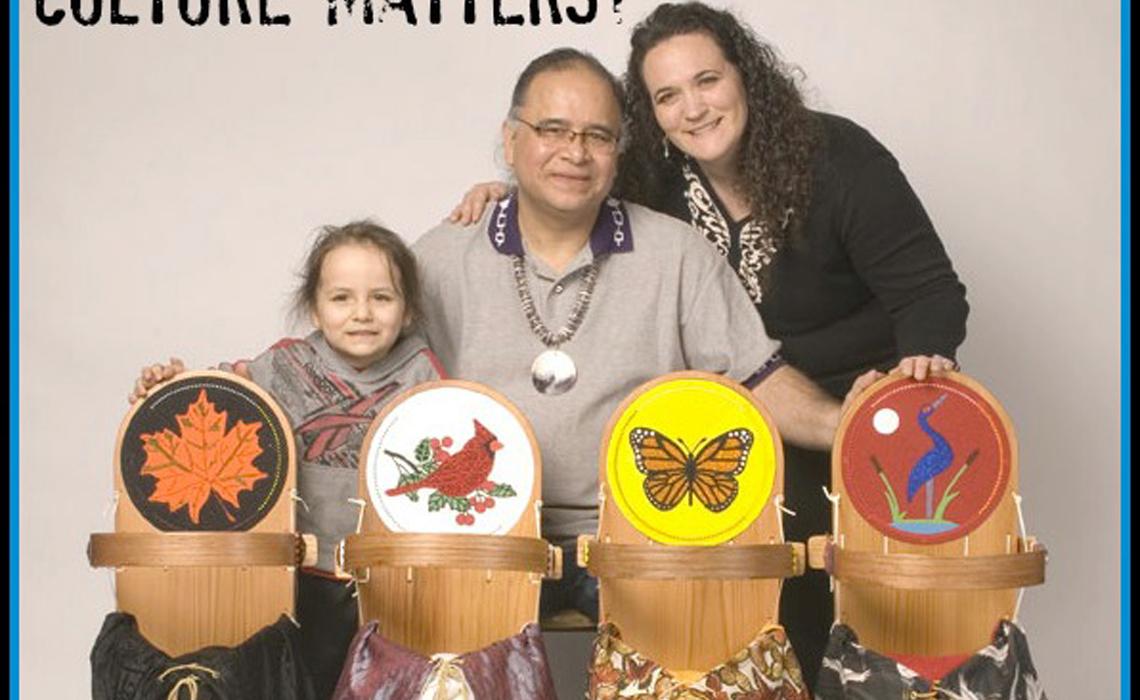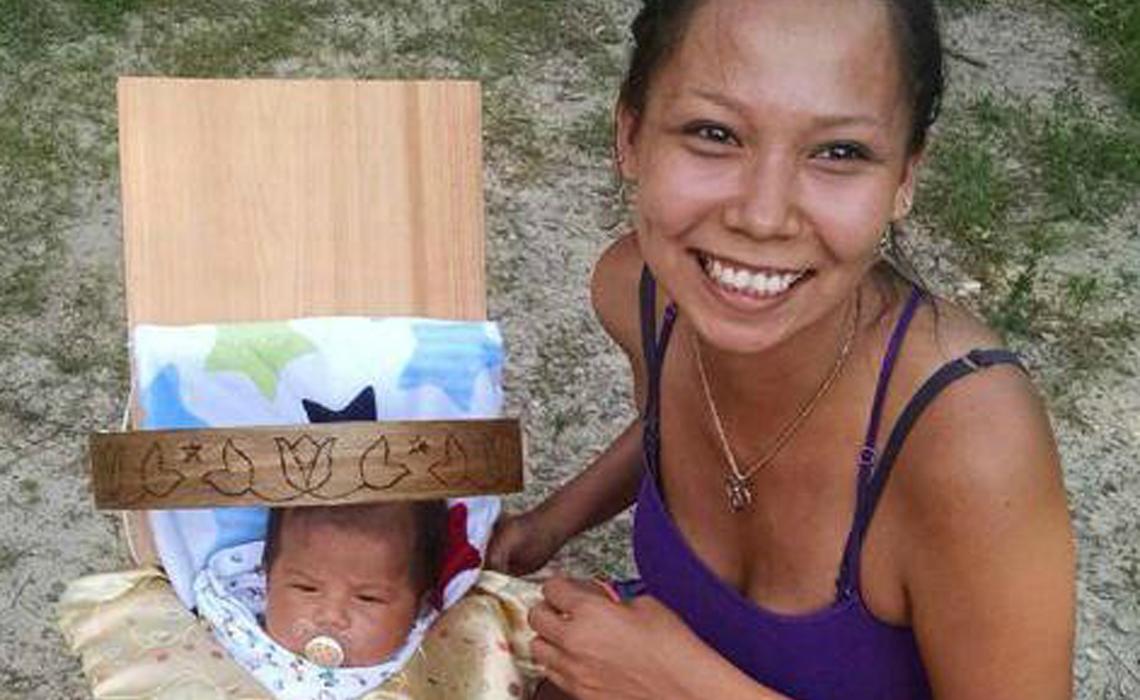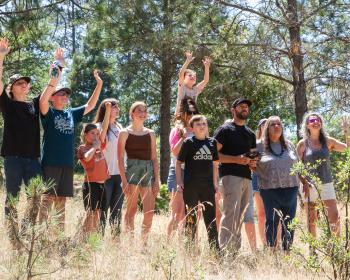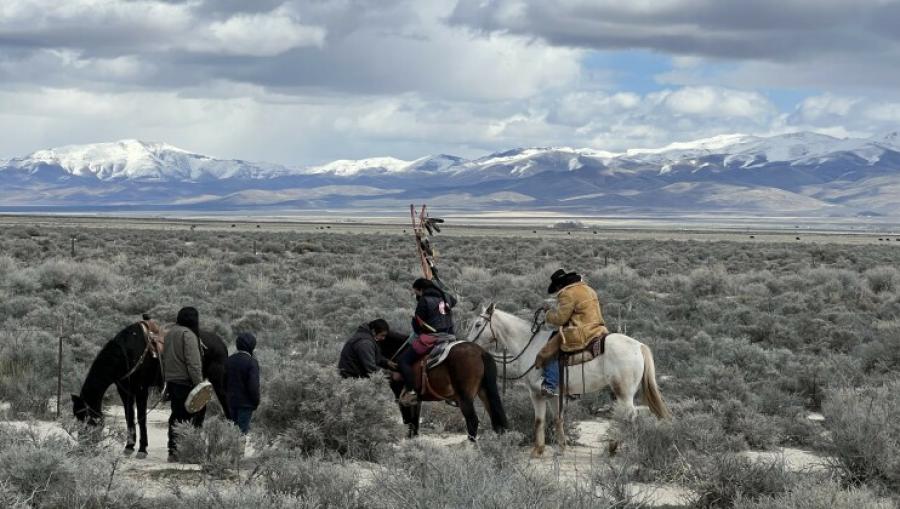

By Asia Alsgaard
Douglas Limón (Oneida) is an artist in White Bear Lake, Minnesota who is well known for his beadwork, however, he was drawn to cradleboard construction by the birth of his youngest son Gavino. Unfortunately, he found few people who could help him. Eventually, he was able to learn from Judy Pamp while they were attending an arts festival in Saginaw, Michigan. He was able to successfully construct a cradleboard for his son and has since continued to construct cradleboards.
Cradleboards are a traditional Native American method mothers used to carry their infants in a way that allowed them to freely use their hands. A variety of Southwestern, Eastern Woodlands, and Northern Plains Tribes have traditionally used cradleboards such as the Apache, Hopi, Lakota, Crow, Iroquois, and Penobscot among many others. Each tribe has its own unique version. For instance, the Navajo constructed cradleboards from lashed wooden rods while Oneida cradleboards were constructed using wood boards and leather strips. Other types were woven moss bags attached to wooden frames or baskets. Within any one tribe, the cradleboards were unique. The family would make the cradleboard around the time of the new infant’s birth. They were made with the care of the infant in mind, often with protective measures to ensure that the infant would remain safe if the board were to fall, but also with attached designs and toys. The end result was a unique product that brought the whole family together, both old and new, in its construction.
Currently, cradleboards are no longer widely used. Historically, white missionaries and societal reformers attempted to stop the use of cradleboards as a method of suppressing native culture. As a result, the knowledge of cradleboard construction has decreased within modern tribes. Even today, the practice continues to be attacked with many citing outdated studies relating the practice to hip dysplasia. Limón has worked hard to combat these misconceptions and provide opportunities for modern native peoples to relearn the traditional method of cradleboard construction.
Since 2008, Limón, at times assisted by his wife, has provided classes for Native Americans interested in learning the skill of Ojibwe cradleboard construction. Impacting his own style to the process, Limón has added beaded inlays to the baseboard. He has successfully funded two separate classes and is now attempting his biggest Kickstarter campaign yet.
Limón has partnered with the Native American Community Clinic (NACC) in Minnesota to provide four separate cradleboard construction classes to the clinic members. 85 percent of the members are Native American with 60 percent receiving Medicaid and 25 percent underinsured. Partially funded by a Partners in Participation grant from the Minnesota State Legislature, the total project cost is $31,495 and he hopes to raise $10,000 more using Kickstarter. In a press release he said the major expenses of the work are associated with prepping the 10 cradleboards for each class, materials, and the artists’ time taken for providing these classes. The classes are planned run through June 2015.
Despite having done previous classes and projects partially funded by grants, this one is different because of his partnership with NACC. While he notes that there were a number of reasons why he approached NACC with the idea for the cradleboard classes, one of the biggest was because of how well their goals fit together: “Artistic expression can be a powerful means of personal transformation and emotional and spiritual healing. I wanted to share that experience with other NACC clients.” With 85 percent of NACC’s clientele identifying as Native American, cradleboard construction was a perfect craft to choose. As a result, NACC was receptive to the project. The Bois Forte Urban Office plans to host the space for the classes as well as provide sewing machines.
Limón has been constructing cradleboards now for years since his foray into the craft having been prompted by the birth of his youngest son, whose cradleboard will be on exhibit at the Science Museum of Minnesota in St. Paul until 2018. He found that much of the community wished to use and make cradleboards, but lacked the skills to do so. His first two classes were funded by partially by Kickstarter campaigns and partially by Minnesota State Arts Board grants. The first was in 2011 for his first cradleboard construction project where he successfully met his goal of $5,000. The Cradleboard Project culminated in four cradleboards, each one representing one of the four seasons. “They have since received a number of awards and have been exhibited at a number of locations. It’s been a very positive impact on our culture and community.”
The second raised $7,000 for his Bandolier Bag project. Bandolier Bags are traditional bead bags originating among the Ojibwe, Menominee, Potawatomi, and Ho-Chunk in the Upper Great Lakes Region of the US and Canada. This project was also met with support and enthusiasm.
Limón has largely been met with a positive response for his projects, being approached by everyone from individuals—who Limón teaches with the understanding that his student promises to pass on the skill to at least one other person—to the Leech Lake Tribal College. He has seen a very direct impact with past students sending photos of cradleboards they have made, with mothers and grandparents making cradleboards for their expected sons or daughters. Making a cradleboard not only preserves some of the Oneida culture, but it creates a sense of connectedness within a family and community.
However, not all of the reactions to the Cradleboard Projects have been positive. Limón has dealt with insulting comments and misinformation. More than one has cited an outdated study linking cradleboards to hip dysplasia and he has taken the effort to address this inaccurate information and explain the numerous benefits of the cradleboard. “The baby feels safe and secure when swaddled in the cradleboard. The baby is bonding with the mother. Babies raised in cradleboards typically walk before babies without cradleboards because in their upright position they strengthen their leg muscles, back muscles, and neck muscles. I also believe they get the idea to walk sooner because they are at eye level with adults. They see everyone walking around,” he says. However, these comments have not come from within the community and they are a reminder to Limón that one of the reasons he continues to construct cradleboards is to alleviate the misinformation that exists and to foster cultural understanding.
For the future, Limón plans to continue with his cradleboard projects and exhibits. He hopes for an exhibit of all the cradleboards that will be constructed during the NACC classes. Rather than being a one-time opportunity, the classes represent to Limón the opportunity to continuously pass on the knowledge of cradleboard as a way of fostering families and communities. He notes that his craft of choice is beadwork and that he has a “large contemporary beadwork piece I am working on. I’m not ready to unveil it but I do believe it will be the first of its kind.” With past classes in cradleboards and Bandolier bags, who know what might be next.
To learn more, visit: https://www.kickstarter.com/projects/limon/cradleboards-to-preserve-our-past-and-protect-our
Photos courtesy of Dave Olsen and The Cradleboard Project.



